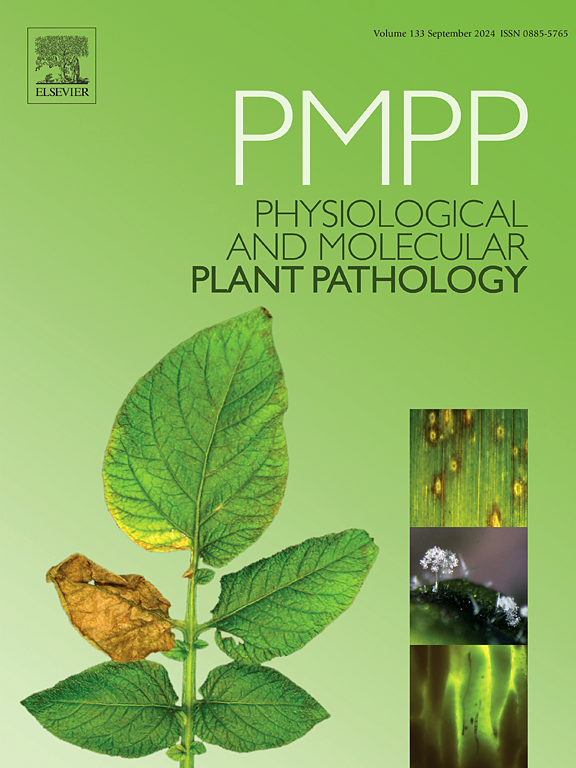Osthole–pyrethrins combination loaded onto hollow microsphere silica nanoparticles inhibits Fusarium solani growth and controls root rot incidence in Cynanchum auriculatum
IF 2.8
3区 农林科学
Q2 PLANT SCIENCES
引用次数: 0
Abstract
This study investigated the synergistic effects of compound bio-derived fungicide against Fusarium solani, the pathogen of root rot in Cynanchum auriculatum (CA), and the enhancement effect of loading these combinations through hollow microsphere silica nanoparticles (HMSNs). The mycelial growth rate method was used to evaluate the inhibition rates and EC50 values of eight biogenic fungicides. Highly active fungicide were identified, and their co-toxicity coefficients (CTCs) and combined toxicity were determined. A pot experiment was conducted using HMSN-loaded fungicide combinations. Among the eight fungicides tested, F. solani showed greatest sensitivity to pyrethrins, eugenol, and osthole, with EC50 values of 2.00, 9.49 and 10.90 mg/L, respectively. Of the 27 mixtures tested, the osthole–pyrethrins combination in 1:0.275 ratio exhibited the highest CTC (139.87) and the lowest EC50 (4.00 mg/L), demonstrating a strong synergistic effect. The HMSN-loaded mixture (CS@HMSN) significantly inhibited F. solani growth at all tested concentrations. At 50 mg/L, CS@HMSN achieved the lowest disease incidence (12.50) and incidence rate (33.33 %) while also activating defense enzymes such as superoxide dismutase, catalase, and peroxidase. This alleviated the adverse effects of F. solani on CA and improved plant resilience. These findings suggest that 50 mg/L CS@HMSN is a promising fungicide formulation for the biological control of CA root rot, offering an effective alternative to chemical fungicides while enhancing sustainability in production systems.

空心微球二氧化硅纳米颗粒载虫孔-除虫菊酯复合抑制木耳镰刀菌生长和根腐病发生
研究了复合生物源杀菌剂对金秋木耳根腐病病原菌枯萎病菌(Fusarium solani)的增效作用,以及空心微球二氧化硅纳米颗粒(HMSNs)对复合生物源杀菌剂的增效作用。采用菌丝生长速率法评价8种生物源杀菌剂的抑菌率和EC50值。鉴定出高活性杀菌剂,测定其共毒系数(ctc)和联合毒力。采用载hmsn杀菌剂组合进行盆栽试验。8种杀菌剂中,茄蚜对除虫菊酯、丁香酚和蛇床子素最敏感,EC50值分别为2.00、9.49和10.90 mg/L。其中,以1:0.275比例的蛇床子酚与除虫菊酯的CTC最高(139.87),EC50最低(4.00 mg/L),具有较强的协同作用。负载hmsn的混合物(CS@HMSN)在所有测试浓度下都能显著抑制梭菌的生长。在50 mg/L时,CS@HMSN的发病率最低(12.50%),发病率最低(33.33%),同时还能激活超氧化物歧化酶、过氧化氢酶和过氧化物酶等防御酶。这减轻了茄菌对CA的不利影响,提高了植物的抗逆性。这些研究结果表明,50 mg/L CS@HMSN是一种很有前景的CA根腐病生物防治杀菌剂配方,可有效替代化学杀菌剂,同时提高生产系统的可持续性。
本文章由计算机程序翻译,如有差异,请以英文原文为准。
求助全文
约1分钟内获得全文
求助全文
来源期刊
CiteScore
4.30
自引率
7.40%
发文量
130
审稿时长
38 days
期刊介绍:
Physiological and Molecular Plant Pathology provides an International forum for original research papers, reviews, and commentaries on all aspects of the molecular biology, biochemistry, physiology, histology and cytology, genetics and evolution of plant-microbe interactions.
Papers on all kinds of infective pathogen, including viruses, prokaryotes, fungi, and nematodes, as well as mutualistic organisms such as Rhizobium and mycorrhyzal fungi, are acceptable as long as they have a bearing on the interaction between pathogen and plant.

 求助内容:
求助内容: 应助结果提醒方式:
应助结果提醒方式:


